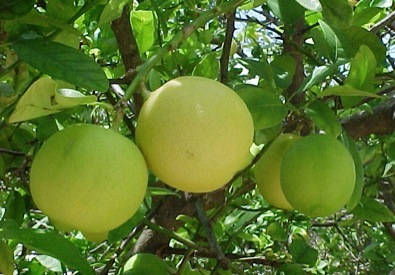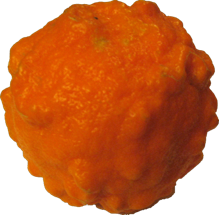
Without attention citrus reverts back towards original forms
Feral Citrus: Snack, Seasoning and Soap
Citrus, like apples when left unattended by man, tend to revert to their natural state of being sour and acidic. A lot of folks think that makes them inedible but that is not true plus they have other uses.

A “wild” orange, usually highly acidic
Some wild citrus has kept its palatability, the Key Lime (Citrus aurantifolia) is a good example. Imported from Asia to the West Indies and naturalized in the Keys it is perhaps the most prized of small limes. A piece of authentic key lime pie is indeed a treat. Another naturalized citrus that is not that pleasant is the Sour Orange or Seville Orange, Citrus aurantifolium. You can use it to wash your hair.
Contact with the feisty key lime can cause an itchy rash on exposure to the sun, or burn and blister sensitive individuals. The Sour Orange is so acidic it cannot be eaten as is. Its juice, however, can make an ade and be used as a seasoning. The pulp and peel can be used for marmalade. In fact, the fruit and leaves can be crushed and used like soap, and it will lather. It can also be used to shampoo with. Also remember that citrus acid can be used to cook some shellfish and small pieces of fish. Simply put the food in the acid and let it sit for an hour or so until done.
Other wild citrus vary from still edible to be used for washing. I have an old tangerine grove near me and some of those trees still produce edible fruit. In nearby Spring Hammock, the wild oranges taste like lemons. You simply have to try them. Best advice is to chew a little well, spit it out and wait about 30 minutes. If the fruit is too acidic it will show up within that time. If not consume as one would any citrus. Don’t, however, be fooled by initial sweetness. That can still mask considerable acid. Chew it, spit it out, and wait. Then decide.
Botanically they are Citrus aurantifolia (KIT-roos aw-ran-tee-FOH-lee-ah) and Citrus aurantifolium (KIT-roos aw-ran-tee-FOH-lee-um) Citrus came form the Latin word for the citron tree but the Romans got it through the Etruscans who got it from the Greek word “kedros” meaning cedar. Both endings mean golden leaf.
Green Deane’s “Itemized” Plant Profile
IDENTIFICATION: Key Lime: Small tree or straggling shrub to 15 feet, numerous sharp thorns, leave alternate, oval to elliptical, usually rounded at the tip, edges minutely scalloped, stalks winged, strong lime aroma. Fruit round, one to two inches, green when unripe, yellow when ripe, pulp greenish juicy, sharply acidic. Seville Orange: Shrub to tree to 30 feet, long sharp thorns, leaves ovate to elliptic, often pointed, to four inches long, fruit round to three inches wide, reddish orange, roughly pitted, thick bitter rind, pulp orange, somewhat bitter, core hollow, seeds ivory white, oval.
TIME OF YEAR: Fall and spring but also nearly all year in warm areas, seasonal in others, which can be fall or spring.
ENVIRONMENT: Abandoned homesteads and campsites, other citrus virtually any where it will survive the winters
METHOD OF PREPARATION: Juice from both can be used for an ade or seasoning. Both can also be used cooked. Non-acidic wild citrus can be eaten as is.

